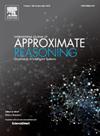分治法用于因果计算
IF 3
3区 计算机科学
Q2 COMPUTER SCIENCE, ARTIFICIAL INTELLIGENCE
引用次数: 0
摘要
结构因果模型是因果和反事实推理的强大框架,扩展了传统贝叶斯网络的能力。这些模型包括内生变量和外生变量,其中外生变量经常缺乏明确的语义解释。外生变量通常是不可观察的,使得某些反事实查询无法识别。在这种情况下,贝叶斯网络的标准推理算法是不够的。最近的方法试图通过对外生概率的不精确估计来绑定无法识别的查询。然而,随着外生变量基数的增加,这些方法在计算上变得不可行,从而限制了适用模型的复杂性。在本文中,我们研究了一种分而治之的方法,该方法将一般因果模型分解为一组具有低基数外生变量的子模型,从而能够精确计算这些子模型中的任何查询。通过聚合子模型的结果,获得了原始模型中查询边界的有效近似值。我们的建议能够处理具有任何基数的变量的模型,假设没有未观察到的混杂因素。我们证明了该方法在理论上具有鲁棒性,实验结果表明,与现有技术相比,它可以以更低的计算成本获得更准确的边界。本文章由计算机程序翻译,如有差异,请以英文原文为准。
Divide and conquer for causal computation
Structural causal models are a powerful framework for causal and counterfactual inference, extending the capabilities of traditional Bayesian networks. These models comprise endogenous and exogenous variables, where the exogenous variables frequently lack clear semantic interpretation. Exogenous variables are typically unobservable, rendering certain counterfactual queries unidentifiable. In such cases, standard inference algorithms for Bayesian networks are insufficient. Recent methods attempt to bound unidentifiable queries through imprecise estimation of exogenous probabilities. However, these methods become computationally infeasible as the cardinality of the exogenous variables increases, thereby constraining the complexity of applicable models. In this paper we study a divide-and-conquer approach that decomposes a general causal model into a set of submodels with low-cardinality exogenous variables, enabling exact calculation of any query within these submodels. By aggregating results from the submodels, efficient approximations of bounds for queries in the original model are obtained. Our proposal is able to handle models with variables of any cardinality assuming that there are no unobserved confounders. We show that the method is theoretically robust, and experimental results demonstrate that it achieves more accurate bounds with lower computational costs compared to existing techniques.
求助全文
通过发布文献求助,成功后即可免费获取论文全文。
去求助
来源期刊

International Journal of Approximate Reasoning
工程技术-计算机:人工智能
CiteScore
6.90
自引率
12.80%
发文量
170
审稿时长
67 days
期刊介绍:
The International Journal of Approximate Reasoning is intended to serve as a forum for the treatment of imprecision and uncertainty in Artificial and Computational Intelligence, covering both the foundations of uncertainty theories, and the design of intelligent systems for scientific and engineering applications. It publishes high-quality research papers describing theoretical developments or innovative applications, as well as review articles on topics of general interest.
Relevant topics include, but are not limited to, probabilistic reasoning and Bayesian networks, imprecise probabilities, random sets, belief functions (Dempster-Shafer theory), possibility theory, fuzzy sets, rough sets, decision theory, non-additive measures and integrals, qualitative reasoning about uncertainty, comparative probability orderings, game-theoretic probability, default reasoning, nonstandard logics, argumentation systems, inconsistency tolerant reasoning, elicitation techniques, philosophical foundations and psychological models of uncertain reasoning.
Domains of application for uncertain reasoning systems include risk analysis and assessment, information retrieval and database design, information fusion, machine learning, data and web mining, computer vision, image and signal processing, intelligent data analysis, statistics, multi-agent systems, etc.
 求助内容:
求助内容: 应助结果提醒方式:
应助结果提醒方式:


